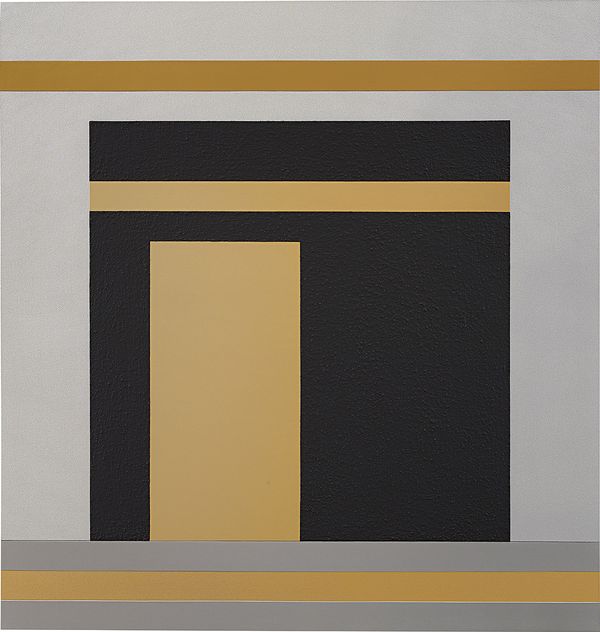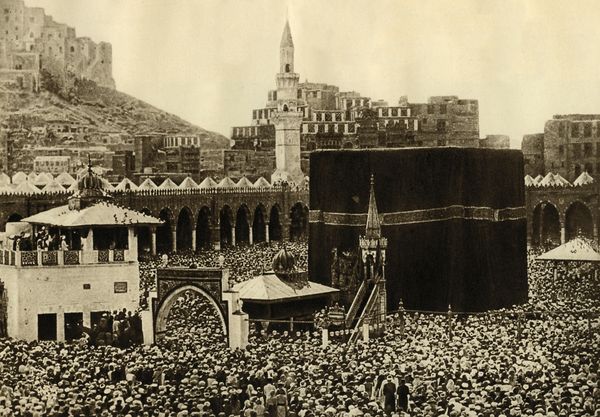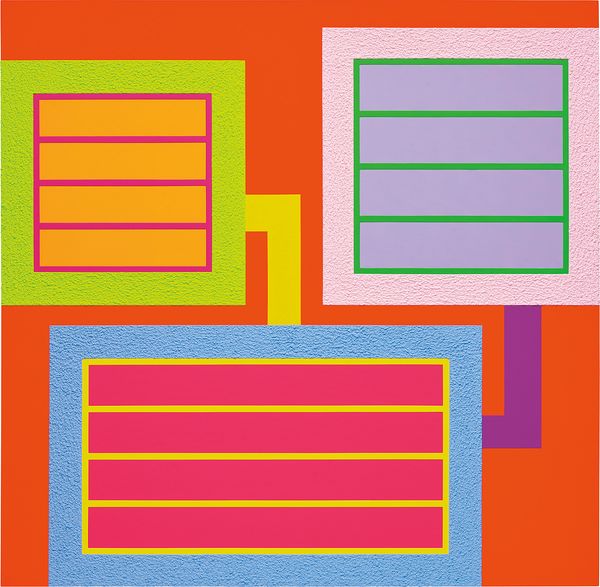Peter Halley Direction No. 7, 2014
Direction No. 7 is a powerfully commanding example from Peter Halley’s Direction series, influenced by the demandingly austere authority of the Kaaba, Mecca, to which all Muslim prayer is directed. Included in the artist’s exhibition at Mottahedan Projects, Dubai, Direction No. 7 is arresting and immediate, constructed with Halley’s rigorous formal language and bold aesthetic in uniform silver, gold and black. Executed in textured Roll-a-Tex, Halley’s physical signifier and ready-made imitation of painterly impasto, Direction No.7 takes on a distinct architectural quality, intensified by the geometric, structural precision of the composition.
The central black square, dominating the composition, echoes Malevich’s Black Square, a symbol of transcendence and avant-garde aspiration. "In the year 1913, trying desperately to free art from the dead weight of the real world, I took refuge in the form of the square" (Kasimir Malevich, The Non-Objective World: The Manifesto of Suprematism, 1926). The refuge Malevich found in the square can be physically and spiritually found at the Kaaba and is vigorously emulated in Peter Halley’s Direction No. 7.
I was interested in the parallels between the stark form of the Kaaba and the squares and cubes of Minimalist art, which was then at its moment of greatest influence. There is no other great religious shrine in the world that is as austere as the Kaaba.
Pilgrims at the Kaaba, c. 1925, Mecca, Saudi Arabia. Image: Lebrecht History / Bridgeman Images
Direction No. 7, the largest and the last of the Direction series, delves deeper into earlier themes that Halley had explored. "Back in the 1970’s I also made several small gouache paintings with square and cubic forms referring to the architecture of the Kaaba. I was interested in the parallels between the stark form of the Kaaba and the squares and cubes of Minimalist art, which was then at its moment of greatest influence. There is no other great religious shrine in the world that is as austere as the Kaaba. Except for the entrance door, the exterior is free from any trace of historical styles. It is a pure iconic symbol of the house, or sanctuary, with four plain walls covered by a flat roof. Its form is totally functional – the vertical walls enclose the space, while the horizontal roof provides shelter from the elements" (Peter Halley, interviewed by Salwa Mikdadi in Dubai, A Mottahedan Project, The Awakening: Peter Halley and Pietro Roccasalva).
Throughout Halley’s oeuvre, he has focused on the sociological implication of geometric forms and symbols through the domination of squares, rectangles and lines. In contrast, the external austerity of the Kaaba symbolizes the straight path through life and the upward vertical directional lines of spiritual transcendence, forms and shapes that are boldly replicated in their pure simplicity in Direction No. 7. "I have been interested in a presentation of the architecture of the Kaaba expressed in the language of contemporary painting. The Kaaba embodies many of the themes that have been important to me throughout my life as an artist: iconicity, austerity, enclosure, and sanctuary" (Peter Halley, interviewed by Salwa Mikdadi in Dubai, A Mottahedan Project, The Awakening: Peter Halley and Pietro Roccasalva). Direction No. 7 masterfully embodies Halley’s iconic brand of geometric abstraction and continuous themes in his unique and striking interpretation of the religious focal point.
Peter Halley Bright, 2018. This work will also come to auction at the 20th Century & Contemporary Art Day Sale on 3 October 2019.


